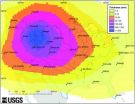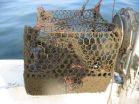(Press-News.org) Rocky planets like Earth start out as microscopic bits of dust tinier than a grain of sand, or so theories predict.
Astronomers using the National Science Foundation's (NSF) Green Bank Telescope (GBT) have discovered that filaments of star-forming gas near the Orion Nebula may be brimming with pebble-size particles -- planetary building blocks 100 to 1,000 times larger than the dust grains typically found around protostars. If confirmed, these dense ribbons of rocky material may well represent a new, mid-size class of interstellar particles that could help jump-start planet formation.
"The large dust grains seen by the GBT would suggest that at least some protostars may arise in a more nurturing environment for planets," said Scott Schnee, an astronomer with the National Radio Astronomy Observatory (NRAO) in Charlottesville, Virginia. "After all, if you want to build a house, it's best to start with bricks rather than gravel, and something similar can be said for planet formation."
The new GBT observations extend across the northern portion of the Orion Molecular Cloud Complex, a star-forming region that includes the famed Orion Nebula. The star-forming material in the section studied by the GBT, called OMC-2/3, has condensed into long, dust-rich filaments. The filaments are dotted with many dense knots known as cores. Some of the cores are just starting to coalesce while others have begun to form protostars -- the first early concentrations of dust and gas along the path to star formation. Astronomers speculate that in the next 100,000 to 1 million years, this area will likely evolve into a new star cluster. The OMC-2/3 region is located approximately 1,500 light-years from Earth and is roughly 10 light-years long.
Based on earlier maps of this region made with the IRAM 30 meter radio telescope in Spain, the astronomers expected to find a certain brightness to the dust emission when they observed the filaments at slightly longer wavelengths with the GBT.
Instead, the GBT discovered that the area was shining much brighter than expected in millimeter-wavelength light.
"This means that the material in this region has different properties than would be expected for normal interstellar dust," noted Schnee. "In particular, since the particles are more efficient than expected at emitting at millimeter wavelengths, the grains are very likely to be at least a millimeter, and possibly as large as a centimeter across, or roughly the size of a small Lego-style building block."
Though incredibly small compared to even the most modest of asteroids, dust grains on the order of a few millimeters to a centimeter are incredibly large for such young star-forming regions. Due to the unique environment in the Orion Molecular Cloud Complex, the researchers propose two intriguing theories for their origin.
The first is that the filaments themselves helped the dust grains grow to such unusual proportions. These regions, compared to molecular clouds in general, have lower temperatures, higher densities, and lower velocities -- all of which would encourage grain growth.
The second scenario is that the rocky particles originally grew inside a previous generation of cores or perhaps even protoplanetary disks. The material could then have escaped back into the surrounding molecular cloud rather than becoming part of the original newly forming star system.
"Rather than typical interstellar dust, these researchers appear to have detected vast streamers of gravel -- essentially a long and winding road in space," said NRAO astronomer Jay Lockman, who was not involved in these observations. "We've known about dust specks and we have known that there are things the size of asteroids and planets, but if we can confirm these results it would add a new population of rocky particles to interstellar space."
The most recent data were taken with the Green Bank Telescope's high frequency imaging camera, MUSTANG. These data were compared with earlier studies as well as temperature estimates obtain from observations of ammonia molecules in the clouds.
"Though our results suggest the presence of unexpectedly large dust grains, measuring the mass of dust is not a straightforward process and there could be other explanations for the bright signature we detected in the emission from the Orion Molecular Cloud," concluded Brian Mason, an astronomer at the NRAO and co-author on the paper. "Our team continues to study this fascinating area. Since it contains one of the highest concentrations of protostars of any nearby molecular cloud it will continue to excite the curiosity of astronomers."
A paper detailing these results is accepted for publication in the Monthly Notices of the Royal Astronomical Society.
The GBT is the world's largest fully steerable radio telescope. Its location in the National Radio Quiet Zone and the West Virginia Radio Astronomy Zone protects the incredibly sensitive telescope from unwanted radio interference.
Later this year, the GBT will receive two new, more advanced high frequency cameras: MUSTANG-1.5, the even-more-sensitive successor to MUSTANG, and ARGUS, a camera designed for mapping the distribution of organic molecules in space.
INFORMATION:
The National Radio Astronomy Observatory is a facility of the National Science Foundation, operated under cooperative agreement by Associated Universities, Inc.
Orion rocks! Pebble-size particles may jump-start planet formation
2014-08-27
ELSE PRESS RELEASES FROM THIS DATE:
AGU: Yellowstone supereruption would send ash across North America
2014-08-27
WASHINGTON, D.C. – In the unlikely event of a volcanic supereruption at Yellowstone National Park, the northern Rocky Mountains would be blanketed in meters of ash, and millimeters would be deposited as far away as New York City, Los Angeles and Miami, according to a new study.
An improved computer model developed by the study's authors finds that the hypothetical, large eruption would create a distinctive kind of ash cloud known as an umbrella, which expands evenly in all directions, sending ash across North America.
A supereruption is the largest class of volcanic ...
'Junk' blood tests may offer life-saving information
2014-08-27
Tel Aviv — Some 30 percent of all positive hospital blood culture samples are discarded every day because they're "contaminated" — they reflect the presence of skin germs instead of specific disease-causing bacteria.
Rather than toss these compromised samples into the trash, clinicians may be able to use the resistance profiles of skin bacteria identified by these tests to treat patients with antibiotics appropriate to their ailment, Tel Aviv University researchers say. Dr. Gidi Stein and Dr. Danny Alon of TAU's Sackler Faculty of Medicine and the Department of Internal ...
Big data approach identifies Europe's most dangerous human and domestic animal pathogens
2014-08-27
The pathogens posing the greatest risk to Europe based upon a proxy for impact have been identified by University of Liverpool researchers using a 'big data' approach to scientific research.
The researchers from the University's Institute of Infection and Global Health ranked the top 100 pathogens affecting humans and the top 100 affecting domestic animals using a system which, they believe, will help governments across the continent plan for risks associated with the spread of infectious diseases, including as a result of climate change, and for biosecurity.
The top ...
Drug represents first potential treatment for common anemia
2014-08-27
(WASHINGTON, August, 27, 2014) – An experimental drug designed to help regulate the blood's iron supply shows promise as a viable first treatment for anemia of inflammation, according to results from the first human study of the treatment published online today in Blood, the Journal of the American Society of Hematology
Anemia is a condition that occurs when red blood cells are in short supply or do not function properly. When an individual has anemia, the body does not get enough oxygen, since there are fewer red blood cells to carry the iron-rich protein hemoglobin ...
Pacific plate shrinking as it cools
2014-08-27
HOUSTON – (Aug. 27, 2014) – The tectonic plate that dominates the Pacific "Ring of Fire" is not as rigid as many scientists assume, according to researchers at Rice University and the University of Nevada.
Rice geophysicist Richard Gordon and his colleague, Corné Kreemer, an associate professor at the University of Nevada, Reno, have determined that cooling of the lithosphere -- the outermost layer of Earth -- makes some sections of the Pacific plate contract horizontally at faster rates than others and cause the plate to deform.
Gordon said the effect detailed this ...
NOAA's Marine Debris Program reports on the national issue of derelict fishing traps
2014-08-27
Thousands of fishing traps are lost or abandoned each year in U.S. waters and become what are known as derelict traps, which continue to catch fish, crabs, and other species such as turtles. These traps result in losses to habitat, fisheries, and the watermen who depend on the resources--losses that are largely preventable, according to a newly published NOAA study.
The report, published in the Marine Pollution Bulletin, is the first of its kind to examine the derelict fish trap problem, and so-called "ghost fishing," nationally, and recommends actions to better manage ...
Taking aim at added sugars to improve Americans' health
2014-08-27
Now that health advocates' campaigns against trans-fats have largely succeeded in sidelining the use of the additive, they're taking aim at sugar for its potential contributions to Americans' health conditions. But scientists and policymakers are still wrangling over the best way to assuage the nation's insatiable sweet tooth, according to an article in Chemical & Engineering News (C&EN), the weekly news magazine of the American Chemical Society.
In the article, Stephen Ritter, a senior correspondent at C&EN, notes that growing evidence suggests the overconsumption of ...
Participants of cardiac clinic trials do not represent real world patients, study finds
2014-08-27
A new analysis of clinical trial participation in the largest ongoing observational study of U.S. heart attack patients has found participants are not representative of the larger patient base, according to a study led by Women's College Hospital cardiologist Dr. Jay Udell. The study authors call into question the general applicability of the findings to the wider population, and suggest the use of broader enrollment criteria and existing patient registries to increase trial participation.
"We know that clinical trials can be tremendously expensive and a huge burden on ...
Promising new cancer therapy uses molecular 'Trash Man' to exploit a common cancer defense
2014-08-27
While many scientists are trying to prevent the onset of a cancer defense mechanism known as autophagy, researchers at Virginia Commonwealth University Massey Cancer Center are leveraging it in a new therapy that causes the process to culminate in cell death rather than survival. The novel treatment strategy targets the p62 protein, which is often referred to as the "Trash Man" due to its role in disposing unwanted cellular proteins during autophagy. Results from preclinical experiments suggest this experimental treatment approach could be particularly effective against ...
Dartmouth isolates environmental influences in genome-wide association studies
2014-08-27
(Lebanon, NH 8/27/14)—Dartmouth cancer researchers developed and tested an advanced statistical model to evaluate the genetic and environmental interactions that contribute to disease as published yesterday in Human Genetics.
The approach fills a gap in current analyses. Complex diseases like cancer usually arise from complex interactions among genetic and environmental factors. When many such combinations are studied, identifying the relevant interactions versus those that reflect chance combinations among affected individuals becomes difficult. In this study, the ...



